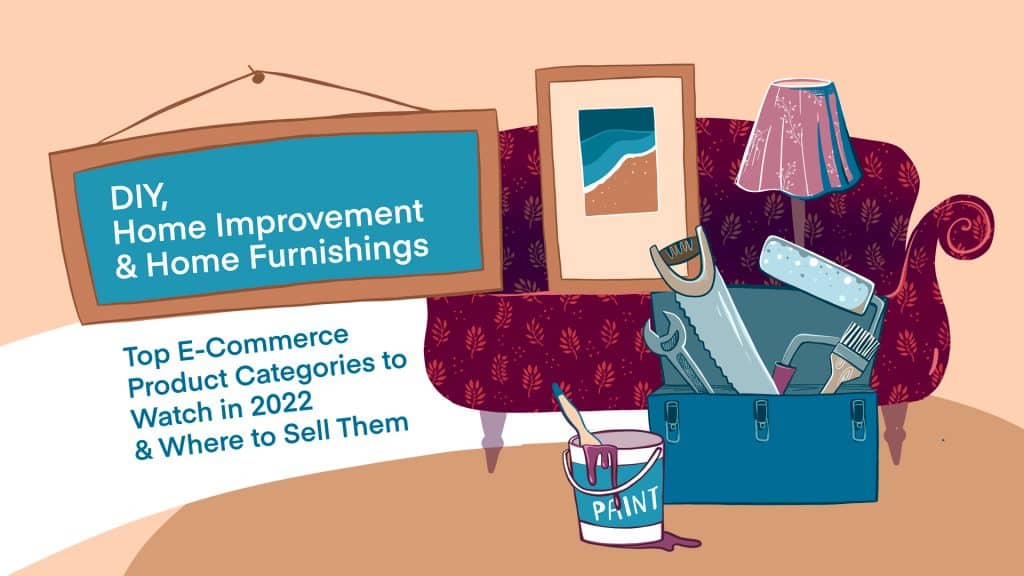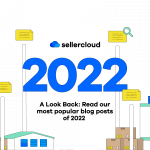
Even with the return of brick-and-mortar retail, e-commerce continues to thrive. However, competition remains fierce.
To remain competitive, growing an online retail brand will require an omnichannel approach.
Not only do you need to sell the products people are looking for, but you also need to be sure that your listings appear where those customers are searching.
Industry-leading marketplaces like Amazon and Walmart will undoubtedly continue to attract the majority of shoppers’ attention in 2022.
However, if the past two years have taught us anything, customers are more comfortable than ever branching out to smaller and more specialized marketplaces to find the best deals, products, and customer experiences.
This means that you need to be everywhere in 2022. Your listings must be on Amazon, Walmart.com, relevant third-party marketplaces, and your first-party website.
Casting a wide net with the right products in the right places should be the core of your e-commerce sales strategy.
Sellers in the following highly competitive sectors should be particularly poised for success in the coming year if they make it a point to sell where the audiences are.
Shoes, Clothing, and Fashion
As people continue to trade in their sweats and loungewear for business casual and formalwear, clothing should continue to be a big seller in 2022.
Moreover, e-commerce should continue gaining ground on brick-and-mortar for years to come.
In their ‘State of Fashion 2022’ report, McKinsey & Company projects that “[b]y 2025, e-commerce is expected to account for one third of all global fashion sales, reaching 40 percent and 45 percent in the US and China respectively.”
To compete in this thriving retail sector as an online seller, there are some specific considerations you need to be sure that you address to remain as attractive to customers as possible:
A Customer-Friendly Return Policy
One of the biggest advantages brick-and-mortar clothing retailers have over online sellers is dressing rooms.
Even with technological advancements like augmented reality, which allows you to visualize online products in your space, there is no way to gauge the fit, feel, or quality of a garment or shoe over the internet.
A clear, simple, and flexible return policy is essential for an online clothier to be viable.
Customers need to know that they can purchase a product and return it hassle-free if they don’t like any aspect of it.
Clear Product Images and Descriptions
Returns are never ideal. Even with a streamlined returns workflow, having customers send items back costs time and money.
By providing accurate measurements, material descriptions, and descriptions of your merchandise, you can help ensure that customers know exactly what they are purchasing.
Images Matter
When it comes to fashion, appearance is everything. Your product images must be clear, optimized, and tailored to your audience.
Social Sells
Clothing, more so than almost any other e-commerce category, is all about image. People want to look good and feel good in what they wear.
When they do, they share it.
This means that not only do you need to be sure your listings cast your products in the best light, but optimizing your images for social media shares can help attract even more customers.
Expanding Your Fashion Brand
If you want to expand your fashion brand into new markets in 2022, several options, including third-party marketplaces, dropshipping opportunities, and first-party website sales, can be leveraged to reach as many audiences as possible.
The Sellercloud omnichannel growth platform features integrations with many of the top go-to destinations for buying clothing, shoes, and fashion accessories online, including:
Hobbies, Collectables, and Crafts
In the past year and a half, many people have used their extra time at home to take up new hobbies or rekindle old ones.
For many, the combination of extra free time and disposable income has created a demand for art materials, crafting tools, and musical instruments.
Some have even turned these pastimes into full-blown side hustles, creating unique and made-to-order items for sale on marketplaces like Etsy and eBay.
Whether you market and sell hand-crafted items yourself or simply have the materials and supplies makers need, there will be plenty of opportunities to achieve strong sales in 2022.
Similarly, the collectibles market continues to be a lucrative sector for those with the right stock. Everything from trading cards to collectible toys to vintage video games to second-hand musical equipment to vinyl records has seen huge jumps in value during the pandemic.
Based on how prices trend upward, this nostalgia boom is unlikely to roll back anytime soon.
If you trade in these types of used or collectible goods, you should take stock of what you have and its market value to strike while the iron is still hot.
Sites like eBay, Bonanza, Etsy, and Reverb are ripe with opportunities to turn your most valuable collectible stock into a profit in 2022.

DIY, Home Improvement, and Home Furnishings
Another area of the economy that continues to experience record highs is real estate.
While your e-commerce business isn’t flipping homes, there is currently a lot of money to be made in the home improvement sector.
With homes flying off the market—some within hours of being listed—many buyers are forgoing traditional house-hunting steps like home inspections and even in-person walkthroughs.
As a result, buyers are left with longer lists of improvements than usual; tackling them as DIY projects can be a savvy way to recoup some of the expenses from a pricey property bidding war.
Along those lines, with home inventories at record lows, more people are choosing (or forced) to make the most out of their current homes while they wait for the housing market to cool.
For online sellers in the home improvement and home goods lanes, 2022 should be another strong one.
Sellercloud’s integrations with home improvement channels like Home Depot, as well as home furnishing marketplaces like Overstock, Hayneedle, Wayfair, and Bed Bath & Beyond, mean that you can start listing and selling directly to some of the most active home improvement customer bases today.
Office Products
Whether resupplying the workplace or sprucing up the home office, desk and productivity products remain big sellers.
It is no surprise that office chairs, pens, pencils, and tablet computers made Shopify’s latest list of trending products.
As an e-commerce seller, selling office supplies like these is a great way to branch out from business-to-consumer (B2C) sales and start reaching business-to-business (B2B) customers.
That said, the process isn’t as simple as listing the products businesses want to purchase and hoping for the best.
If you plan to do B2B ecommerce in 2022, avoid making some of the most common and costly mistakes.
If your products appeal to the home office, corner office, or cubicle crowd, you must go where the audience is searching.
Whether selling to businesses or individual consumers, high quality and low costs drive purchasing decisions.
Make it a point to get your listings on reputable office supply destinations like NewEgg and Staples, as well as larger marketplace destinations renowned for low prices like Amazon and Walmart.
Furthermore, if you sell furniture or decor suitable for the workplace, don’t forget about marketplaces like Wayfair and Overstock!
Broaden Your Omnichannel Reach and Make 2022 Your Most Profitable Year of Ecommerce Yet
Regardless of what you sell—whether in one of the categories above or not—the strategic importance of an omnichannel business model is paramount.
However, there are inherent challenges whenever you launch a new e-commerce channel or target a new audience.
To keep everything streamlined and running smoothly, you need a platform that allows you to manage it all.
Sellercloud has been designed from the ground up to replace the patchwork of websites, partnerships, and tools required for multi-channel e-commerce with a truly unified, seller-friendly solution.
Whether it’s managing your catalog, running your warehouse, tracking inventory, or managing your stock, our 350+ integrations with online marketplaces, shipping providers, shopping carts, vendors, payment processors, logistics partners, and more put the tools that you need to become an omnichannel brand right at your fingertips.
Contact us directly for a free demo to see how Sellercloud’s features and products can give you the competitive edge you need to make the most out of your online sales.




